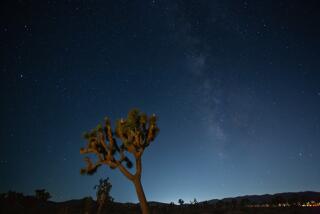Photography : Picturing the Perfect Vacation : Photo tours offer special instruction plus the time and opportunity to take good shots.
After a two-week safari through Kenya and Tanzania several years ago, I rushed to have my 100 rolls of film developed, anticipating award-winning shots. To my dismay, what I got back were landscapes that were too light, villages that were underexposed and wildlife that looked like little dots on the horizon.
In contrast, a friend who made a nearly identical trip, and was about on a par with me as a photographer, returned with wonderful pictures of people, places and animals.
The difference: She had gone on a specialized photo safari and I had simply gone on a safari and taken pictures. While I was guessing about exposure metering and flash use, and toting around a 35- to 70-millimeter lens that was inadequate for wildlife work, she was getting expert help from photographer/guides who knew precisely the kind of camera settings Africa required, and shooting with the 300-millimeter lens that her pre-trip checklist recommended for closing in on animals.
For the serious amateur photographer, a photo tour is a great way to enjoy the world’s scenic splendors in the company of pros who can help you effectively capture the sights on film.
While 10 years ago such specialized tours usually were limited to photo safaris in Africa and India, these days all manner of destinations are considered grist for the film lab.
You can helicopter onto the frozen ice floes of Eastern Canada’s St. Lawrence Gulf to snap fluffy white seal pups and their nursing moms; canoe through Florida’s J.N. (Ding) Darling Wildlife Refuge on Sanibel Island, focusing on alligators and exotic bird life; swoop down on Alaska’s Chilkat River to photograph thousands of bald eagles feeding on spawning salmon, and even scuba into the Hawaiian Pacific and emerge with shots of hammerhead sharks and Day-Glo fish that will be developed by experts on a live-aboard dive boat.
“Photographers--even amateurs--need different things from a tour than mere snap-shooters,” said David Blanton, owner of Voyagers Photo Tours, a 10-year-old Ithaca, N.Y., company that runs 25 photography-oriented trips annually. The company also organizes dozens of non-specialized trips, but the emphasis is different, Blanton said, using Voyagers’ Tanzania tour as a case in point.
“On a regular Africa trip, everyone’s whisked along the road, snapping shots as they go, making for pictures that often are blurry, over- or underexposed and hastily composed,” Blanton said. “On a photo tour, the drivers spend a lot of time in each place, giving everyone plenty of time to experiment with different camera settings and staying with animals, watching for great action shots. In Tanzania, we might spend seven hours at a Serengeti water hole waiting for a lion to show up.”
Photo tours tend to have fewer participants than regular excursions, which ensures maximum personal attention from the experts on hand, as well as less noise and easier mobility when tracking wild animals or visiting native communities. Also, fewer people are placed in any tracking vehicles used, so there’s plenty of room for equipment, and enough windows--and, in safari vehicles, roof-hatch space--for everyone.
Expect to get up early (the pros consider first light the best light of the day), spend long hours in the field and exert some energy. Photo tours often require greater physical fitness than standard trips, since participants may have to do a lot of walking--sometimes over rough terrain--to get close to animals or reach the best angle for a dramatic landscape shot.
While photo tours provide on-the-go coaching in photography techniques, they are not designed to teach participants the nuts and bolts of camera operation. For that, you’d take a photo workshop, which usually entails structured classes. Photo tour operators expect participants to have a solid basic understanding of their equipment.
What follows is a sampling of upcoming photo tours. Many more are listed each month in Outdoor Photographer and Outside magazines, as well as other nature and wildlife periodicals:
* Nature One Photography’s Feb. 8-13 photo excursion to J.N. (Ding) Darling Wildlife Refuge on Sanibel Island, Fla., is scheduled at the peak of the January-to-March bird migration season. Based in a motel on the island, which is linked by a bridge to the Ft. Myers area, a maximum of eight participants will make daily treks to the reserve’s marshes, nature trails and river estuaries (there’s also an optional canoe trip through the reserve). Ding Darling abounds with herons, egrets, osprey, pelicans, anhingas, spoonbills and other exotic birds, many of which are accustomed to human observers and allow close approach. The group also visits the Corkscrew Swamp Sanctuary, site of the largest virgin baldcypress forest in America, and does location shooting of beaches, lighthouses and other seascapes.
Leader John Finley, who has been a professional photographer for 15 years, leading annual photo trips to Ding Darling, said he spends substantial time coaching participants on specific techniques for photographing birds.
* Voyagers Photo Tours will explore the wildlife and native peoples of Kenya and Tanzania during back-to-back trips, Jan. 25-Feb. 11 (Kenya) and Feb. 13-28 (Tanzania). The trips, which are open to a maximum of 10 people each, will be led by Boyd Norton, a specialist in wildlife and nature photography who has published a number of photo books on Africa and produced picture layouts for National Geographic, Popular Photography and Smithsonian magazines and Sierra Club Calendars. Norton has led a dozen tours of East Africa, as well as a number of photo workshops for Voyagers.
The Kenya trip takes in prime wildlife viewing areas such as Samburu, home of the pastoral Samburu people; the Masai Mara (where optional hot-air balloon rides offer an additional vantage point for shooting landscapes and wildlife) and a private 80,000-acre game sanctuary in the Rift Valley. The Tanzania trip is timed for the annual calving and migration of hundreds of thousands of wildebeests north along the Serengeti plain. Participants also will shoot at Tarangire and Lake Manyara national parks and the Ngorongoro Crater, considered a veritable Noah’s Ark of wildlife.
* Bald eagles are the quest during a weeklong November photo safari to Alaska’s Chilkat River, run by Joseph Van Os Photo Safaris. Each October through January, some 3,000 eagles convene along a five-mile stretch of the river near Haines in southeastern Alaska, attracted by the late fall spawning run of 10-pound chum salmon. Led by Perry Conway, a veteran photographer whose work has appeared in National Geographic, Outdoor Photographer and Audubon magazines, a maximum of 16 participants based in a Haines hotel will make daily excursions to the eagle habitats, using a small bus for tracking.
The scenery in the area is dramatic: sloping mountains, rugged waterways, deep green coastal rain forests and glaciers visible across the Chilkat Inlet.
* In March, Robert Winslow, a well-known, Durango, Colo.-based wildlife photographer, will lead a weeklong Canada seal-watching trip for Natural Habitat Wildlife Adventures. A maximum of 12 participants will fly to the Magdalen Islands north of Halifax, from which they’ll make daily helicopter flights to photograph harp seal pups on the offshore ice floes.
During the annual March birthing season, some 600,000 pups are born on these frozen floes of the St. Lawrence Gulf, and wildlife lovers have encouraged tourism in the area as a commercial alternative to seal hunting. The often frigid conditions (in which camera batteries can freeze up), and the challenge of photographing white seals on white snow in blazing sunlight, make the presence of an expert especially valuable on this trip.
* Underwater photography is one of the fastest-growing segments of the medium; the 10-year-old Aggressor Fleet of live-aboard dive boats includes photography experts, film processing, optional classes and camera equipment rental on its trips throughout the world. One of the most popular tours is to the Pacific depths about 85 miles off Kona, Hawaii, where divers based on an 80-foot catamaran can shoot hammerhead sharks, manta rays, migrating whales and other sea life.
A special “adventure cage” holding 3-4 people affords protection for those who want to photograph the sharks up close. During night dives, the boat’s flood lights attract plankton, which in turn attract manta rays, making for good subsurface shots of the animals swirling around the ocean surface. For an extra charge, slide film can be processed on board, and beginners can take an optional introductory course on underwater photography.
GUIDEBOOK
Focusing on Photo Tours
These companies are among those offering photo tours:
Nature One Photography and Wildlife Adventures, P.O. Box 531, Haddonfield, N.J. 08033; telephone (800) 659-9718. “Sanibel Island’s Ding Darling National Wildlife Reserve Up Close” tour runs Feb. 8-13, 1994; price: $485 plus hotel (about $200), meals and round-trip air fare to Ft. Myers, Fla. The company runs about 20 photography tours a year, mainly in the United States and Canada.
Voyagers Photo Tours, P.O. Box 915, Ithaca, N.Y. 14851; tel. (800) 633-0299. Kenya tour runs Jan. 25-Feb. 11; Tanzania tour runs Feb. 13-28. Trips cost $3,600 apiece plus round-trip air fare to Nairobi. Participants who take both tours get a discount of $400 for a total price of $6,800, plus air fare.
Joseph Van Os Photo Safaris, P.O. Box 655, Vashon Island, Wash. 98070; tel. (206) 463-5383. “Bald Eagles of the Chilkat River, Alaska,” tour runs Nov. 13-19; price: $1,395. Round-trip air fare to Juneau and Haines is extra. A leading purveyor of photo tours, Joseph Van Os runs 50 such trips annually; other upcoming tours include: “Antarctica by Icebreaker,” Jan. 3-25, and “Yellowstone National Park,” Feb. 12-18.
Natural Habitat Wildlife Adventures, One Sussex Station, Sussex, N.J. 07461; tel. (800) 543-8917. “Canada Harp Seal Photo Tour” runs March 5-11. Price depends on the number of helicopter trips to the ice: $2,500 with two trips to the ice, $2,800 with three trips, $3,100 with four trips. Price includes round-trip air fare to the Magdalen Islands from Halifax, Nova Scotia, one night in Halifax on return, and some meals. Other meals and air fare to Halifax are extra.
The Aggressor Fleet, P.O. Drawer K, Morgan City, La. 70381; tel. (800) 348-2628. Photo/diving trips off Kona, Hawaii, run weekly year-round. Prices (for 1994): $1,795 for 7 days, $1,395 for 5 days, $1,195 for 4 days. On-board processing (Ektachrome and Fujichrome slide films only), $10 per roll. Optional underwater photography course, $150. Rental of underwater camera package, including Nikonas V camera, SB-103 strobe, Nikonas close-up kit, and 15-, 28- and 35-millimeter lenses, $250 per week.
More to Read
Sign up for The Wild
We’ll help you find the best places to hike, bike and run, as well as the perfect silent spots for meditation and yoga.
You may occasionally receive promotional content from the Los Angeles Times.






